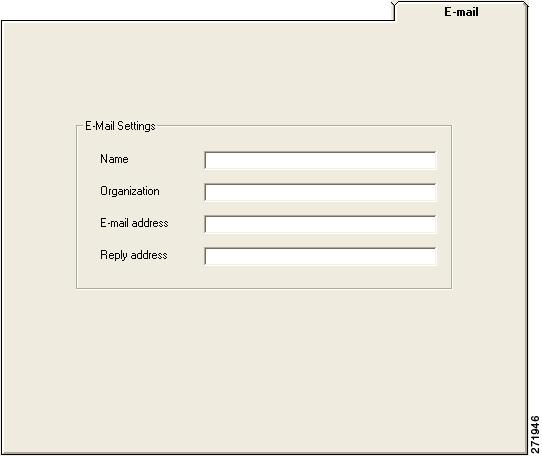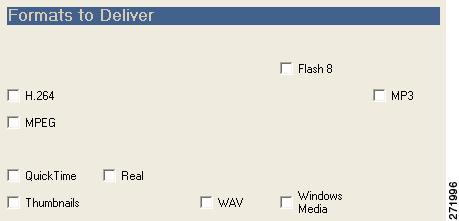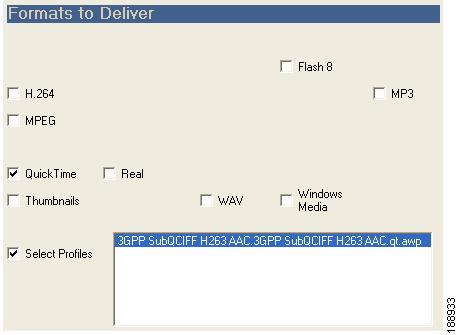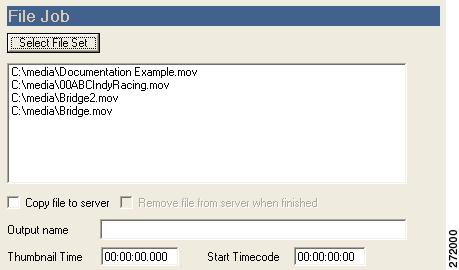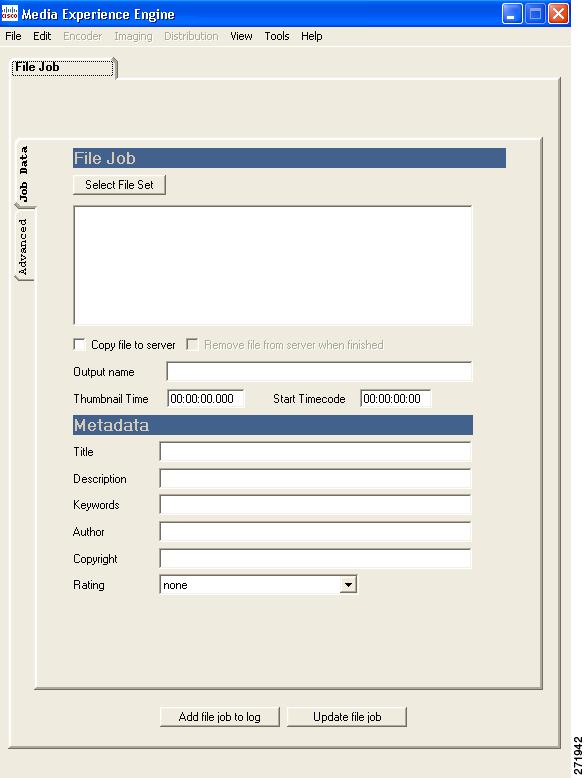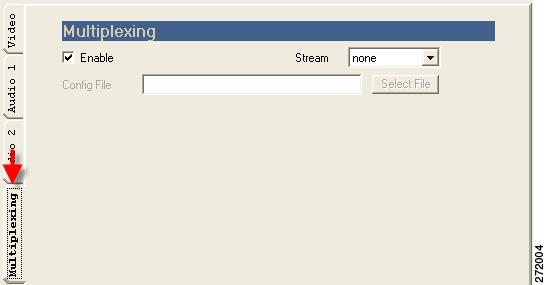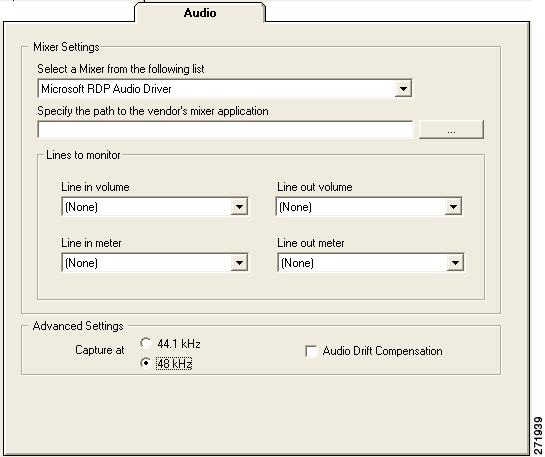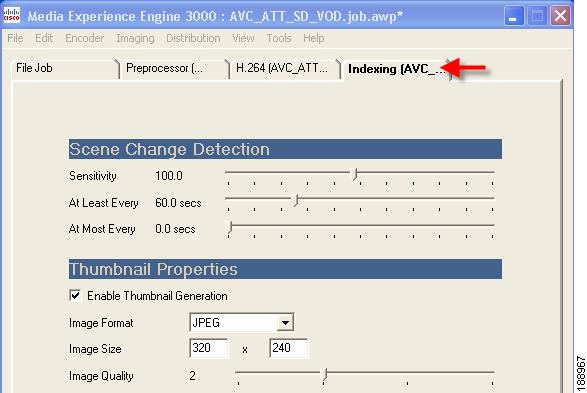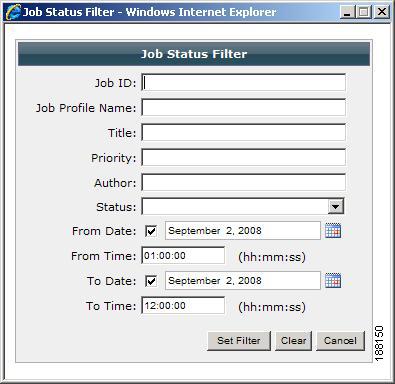 Feedback Feedback
|
Table Of Contents
Release Notes for Cisco Media Experience Engine 3000 Release 2.0
Installation and Upgrade Requirements
Updates for the CLUI Online Help
Standard Cisco MXE 3000 Job Profiles
Understanding Real Encoder Settings: Encoder Properties
Understanding Flash 8 Encoder Settings: Video
Creating a New Job Profile from an Existing Job Profile
Editing an Existing Job Profile
When to Add a Distribution Tab to a Job Profile
Understanding H.264 Encoder Settings: Multiplexing
Understanding Notification Settings
Updates for the Folder Attendant Online Help
Release Notes for Cisco Media Experience Engine 3000 Release 2.0
Revised: June 10, 2009, OL-17000-01
These release notes provide information about the features and caveats for Cisco Media Experience Engine 3000 (Cisco MXE 3000) Release 2.0.
•
Installation and Upgrade Requirements
Introduction
Cisco MXE 3000 is an appliance that provides comprehensive transcoding services and integrates into the network to deliver the following media processing capabilities:
•
Video content to be shared across the network to virtually any type of endpoint
•
Innovative post production features that transform ordinary video content into studio quality output
•
Collaboration with other applications delivered by Cisco's suite of media products
The Cisco MXE 3000 Resource Manager augments the capabilities of the Cisco MXE 3000 by intelligently load balancing job processing across multiple Cisco MXE 3000 devices and by delivering fault tolerance to a Cisco MXE 3000 deployment.
Browser Requirements
You must use one of following web browsers to access the Folder Attendant UI or WebUI:
•
Firefox 2
•
Internet Explorer 6 or later
Note
Firefox 3 is not supported.
For information about the Cisco MXE 3000 components and user interfaces, see the User Guide for Cisco Media Experience Engine 3000 at the following URL:
http://www.cisco.com/en/US/products/ps9892/products_user_guide_list.html
Installation and Upgrade Requirements
The Cisco MXE 3000 is an appliance on which the Cisco MXE 3000 software comes preinstalled.
You can deploy Cisco MXE 3000 in the following two configurations:
•
Standalone Deployment—This deployment consists of one or more Cisco MXE 3000s running as individual devices, each with its own license, user interfaces, job profiles, and so on. The following software product IDs (PIDs) support this deployment: MXE-3000-LIC (MXE 3000 SW)
•
Resource Manager Deployment—This deployment consists of one or more Cisco MXE 3000 devices running as a single group with one set of user accounts, job profiles, licensed features, and user interfaces. There are two types of Cisco MXE 3000 devices in a Resource Manager deployment: a single Cisco MXE 3000 Resource Manager and up to nine Cisco MXE 3000 Resource Nodes. The Resource Manager not only functions as a multidevice manager that load balances transcoding jobs across the Resource Nodes, but also functions as a Resource Node that performs transcoding jobs. The following software PIDs support this deployment:
–
MXE-3000-RM-LIC (MXE 3000 Resource Manager License)
–
MXE-3000-RN-LIC (MXE 3000 Resource Node License)
–
MXE-3000-RM-LIC-U= (MXE 3000 Resource Manager License Upgrade)
–
MXE-3000-RN-LIC-U= (MXE 3000 Resource Node License Upgrade)
For details about obtaining a license file to enable the software for your deployment, see the Deployment and Administration Guide for Cisco Media Experience Engine 3000. This guide also provides information about installing a license, configuring the Cisco MXE 3000, upgrading from a standalone to a Resource Manager deployment, and troubleshooting deployments. You can access the guide at the following URL:
http://www.cisco.com/en/US/products/ps9892/prod_maintenance_guides_list.html
Note
Before you request a software license on Cisco.com for your deployment, see the Deployment and Administration Guide for Cisco Media Experience Engine 3000 for licensing requirements.
Important Notes
Cisco.com Registration Website (Licenses)
•
If you use Cisco MXE 3000 to access the Cisco.com registration website and request a license, you must press Enter to submit the Product Authorization Key to the website instead of clicking the Submit button.
•
For Resource Manager deployments, you must use one MAC address to register the Resource Manager device; use the same Resource Manager MAC address to register each Resource Node; then, install the final license on the Resource Manager. See the Deployment and Administration Guide for Cisco Media Experience Engine 3000 for details.
Standalone and Resource Manager Deployments
•
Directories must be configured only as UNC paths to a network share for Cisco MXE 3000 Resource Manager deployments. Directory locations must be accessible to all Hosts.
•
Directories can be configured as local paths or UNC paths for Cisco MXE 3000 standalone deployments. Directory locations must be accessible to all Hosts.
File Formats
•
A maximum of 8 audio tracks is supported with QuickTime format.
•
Re-wrapping is supported only for MPEG Encoder with an MPEG-PS input file.
Job Profiles
•
Cisco MXE 3000 ships with preconfigured Job Profiles. A Job Profile is a template that defines how jobs are processed, and it contains the settings that are required to process jobs from beginning to end. Job Profiles are optimized for different types of input media, encoding output, and distribution, and they align with modern distribution devices, such as iPod, iTunes, Joost, and so on. See the "Standard Cisco MXE 3000 Job Profiles" section in the User Guide for Cisco Media Experience Engine 3000 to learn more about the preoconfigured Job Profiles.
CautionWe strongly recommend that you use the preconfigured Job Profiles and change settings only if you understand the consequences. Modifying preconfigured Job Profile settings or creating new Job Profiles with settings that media standards do not support can result in job processing failures or produce undesirable output.
User Interface
•
The Live Capture feature is not supported; therefore, the Capture at setting that displays in the CLUI under Tools > Preferences > Audio Preferences is nonfunctional.
•
The Grid Computing feature is not supported; therefore, the Grid Segments setting that displays in the WebUI under Administer > System is nonfunctional.
•
Due to unexpected behavior of Quicktime software, opening the Video Settings dialog from the Quicktime Settings on a system running Quicktime 7.2 may result in a crash. As a workaround, complete the following steps:
1.
Open QuickTime preferences, and select the Advanced tab.
2.
In Video Settings, select Safe mode (GDI only), and click OK.
You can now open the QuickTime video settings dialog box from the QuickTime player.
Caveats
This section includes the following topics:
Using the Bug Toolkit
You can search for problems by using the Cisco Software Bug Toolkit. Known problems (bugs) are graded according to severity level.
Before You Begin
To access Bug Toolkit, you need the following:
•
Internet connection
•
Web browser
•
Cisco.com user ID and password
Procedure
Step 1
To access the Bug Toolkit, go to http://tools.cisco.com/Support/BugToolKit/action.do?hdnAction=searchBugs.
Step 2
Sign in with your Cisco.com user ID and password.
Step 3
To look for information about a specific problem, enter the bug ID number in the Search for Bug ID field, then click Go.
Tip
For information about how to search for bugs, create saved searches, create bug groups, and so on, click Help on the Bug Toolkit page.
Open Caveats
Table 1 describes possible unexpected behavior by Cisco MXE 3000 and includes severity 1, severity 2, and select severity 3 and 4 open caveats. The table is sorted by severity and then by identifier in alphanumeric order.
Because defect status continually changes, this table provides a snapshot of the defects that were open at the time of the release. For an updated list of open defects, access the Bug Toolkit. For details, see the "Using the Bug Toolkit" section.
Troubleshooting
The following Cisco MXE 3000 documents provide troubleshooting information:
•
The Deployment and Administration Guide for Cisco Media Experience Engine 3000 provides troubleshooting information for WebUI and system-level issues.
•
The User Guide for Cisco Media Experience Engine 3000 provides troubleshooting information for the Client User Interface (CLUI) and Folder Attendant UI.
•
The Hardware Installation Guide for Cisco Media Experience Engine 3000 provides troubleshooting information for the appliance hardware.
To access these documents and the Cisco MXE 3000 documentation set, see the Guide to Documentation for Cisco Media Experience Engine 3000 at the following URL:
http://www.cisco.com/en/US/products/ps9892/products_documentation_roadmaps_list.html
Documentation Updates
This section includes the following topics:
•
Updates for the CLUI Online Help
•
Updates for the Folder Attendant Online Help
Updates for the CLUI Online Help
The following changes apply to the CLUI online help in Release 2.0. You can access the latest Cisco MXE 3000 documentation on Cisco.com.
•
Standard Cisco MXE 3000 Job Profiles
•
Understanding Real Encoder Settings: Encoder Properties
•
Understanding Flash 8 Encoder Settings: Video
•
Creating a New Job Profile from an Existing Job Profile
•
Editing an Existing Job Profile
•
When to Add a Distribution Tab to a Job Profile
•
Understanding H.264 Encoder Settings: Multiplexing
•
Understanding Notification Settings
Standard Cisco MXE 3000 Job Profiles
This section now includes information for 55 standard Job Profiles, as opposed to the 20 that are documented in the online help. See the User Guide for Cisco Media Experience Engine 3000 on Cisco.com for more information.
Understanding Real Encoder Settings: Encoder Properties
The description for the Max. Keyframe Spacing setting in the Real Encoder: Encoder Properties Settings, Descriptions, and Values table now states:
Understanding Flash 8 Encoder Settings: Video
The description for the Keyframe Interval in the Flash 8 Encoder: Video Settings and Descriptions table now states:
E-mail Preferences
The E-mail tab, shown in Figure 1, is accessed from the main menu by selecting Tools > Preferences > E-mail Preferences. At this time, the E-mail tab is used to enter information that appears in the job submission metadata only.
Figure 1 E-mail Preferences Tab
Formats to Deliver
Note
You may choose to deliver one or more formats or one or more particular profiles.
Select file types to be delivered to the location defined in the Delivery Method section.
Checking a particular format type will specify that all the encodes for that encoder will be delivered. Unchecked formats are not delivered.
Figure 2 Delivery Tab: Formats to Deliver
Select Profiles
In addition to checking one or more format boxes, check the Select Profiles box, shown in Figure 3, to specify a distribution method limited to certain profiles within the encoder types.
Checking this box allows profiles to be picked from the adjacent list.
Figure 3 Delivery Tab: Select Profiles Checkbox
The Select Profiles box lists the profiles used in the current job. Select only the profiles for which you want to set delivery.
Click on a profile name to select it (or select multiple profiles using the Shift or Ctrl keys). The encoded files generated from the selected profiles are then subject to the delivery method specified on this tab.
If the Select Profiles box is not checked, individual profiles cannot be selected and are grayed out.
Note
To deliver to individual profiles, you must check at least one Format to Deliver, you must check the Select Profiles box, and you must highlight the chosen profile(s).
File Job
The File Job section, shown in Figure 4, is used to select the file or files to be encoded and to set other job parameters, including whether the file needs to be copied to the server before preprocessing and encoding begins, the output name, thumbnail time, and start timecode.
Note
To avoid possible job failures, always check the Copy file to server box.
Figure 4 File Job Section
Table 2 describes the settings.
Creating a New Job Profile
Procedure
Step 1
Log into the CLUI. The main window displays, as shown in Figure 5.
Figure 5 Cisco MXE 3000 Main Window
Step 2
On the main menu, click File > New Job Profile. The Cisco MXE 3000 adds a Preprocessor tab.
Step 3
Adjust Preprocessor settings as needed. See also: Adding Preprocessor Settings to a Job Profile (CLUI).
Step 4
From the main menu, click Encoder, and add at least one encoder to the Job Profile. See also: Adding Encoders to a Job Profile (CLUI).
Step 5
(Optional) From the main menu, click Distribution, and add one or more Distribution tabs to the Job Profile. See also: Adding Distribution Settings to a Job Profile (CLUI).
Step 6
From the main menu, click File > Save Job Profile.
Step 7
Name the profile, and click OK.
Note
Do not begin the Job Profile name with a space, and limit the complete length of the file name, including the full path to 256 characters.
Creating a New Job Profile from an Existing Job Profile
Use this procedure to create a new master profile with all the settings of the existing profile and to link the two profiles so that changes to one are reflected in both profiles. The link between the profiles is indicated by the parenthesis on the type tab in the Main Window, for example MPEG (Joost).
Tip
To remove the link between the profiles, rename the tab by right-clicking the type tab and clicking Change Tab Name.
Procedure
Step 1
Log into the CLUI.
Step 2
On the main menu, click File > Open Job Profile. A browse window will open to the default profile location set in General Preferences.
Step 3
Double-click a Job Profile (similar to the one you want to create) to open it.
Step 4
Make any necessary changes to the various tabs in the Job Profile.
Step 5
Click File > Save Job Profile As, and provide a new name for the new Job Profile.
Note
Do not begin the Job Profile name with a space, and limit the complete length of the file name including the full path to 256 characters.
Editing an Existing Job Profile
Jobs in the Job Log window (unsubmitted jobs) that use a particular profile will be affected by any changes to that profile. Jobs in the Job Status window (submitted jobs) will not be affected. See also: Job Log Window: Managing Jobs Before Submission and Job Status Window: Managing Submitted Jobs.
Procedure
Step 1
From the main menu, click File > Open Job Profile. If a Job Profile is currently open, you will be asked if you want to save the current profile.
Step 2
Click Yes or No. A browser window will open to the default profile location set in General Preferences.
Step 3
Double-click a profile name to open it.
Step 4
Make any necessary changes to the various tabs in the profile.
Step 5
Click File > Save Job Profile.
or
Click Save Job Profile As to save the updated Job Profile under a new name without changing the original file. See also: Creating a New Job Profile from an Existing Job Profile for information about linked profiles.
Note
Do not begin the Job Profile name with a space, and limit the complete length of the file name, including the full path to 256 characters.
When to Add a Distribution Tab to a Job Profile
Distribution tabs allow users and administrators to save encoded output according to their specific business needs in addition to or instead of the default location.
Distribution tabs are not a required component of Job Profiles. By default, output files will be saved to the system default locations. When any type of distribution tab is added to a job or Job Profile, the system default will be overridden. When any type of distribution tab is added to a job or Job Profile, the output file is sent to the location specified on the distribution tab in addition to the default distribution location.
Likewise, distribution tabs are used to automate portions of the encoding workflow. For example, if encoded clips must be reviewed before they are moved to a streaming server, you can add a Delivery tab to automatically send the media to the reviewer's server using FTP, eliminating the need to manually FTP files. Or, if encoding files for an external customer, you can use the Notification tab to automatically post job statuses (via HTTP Post or e-mail) to a site for client reference.
Understanding H.264 Encoder Settings: Multiplexing
Figure 6 shows the Multiplexing tab.
Figure 6 H.264 Encoder: Multiplexing Tab
Table 3 describes the settings.
Understanding Notification Settings
Each Notification tab is made up of five sections used to define when and how notification will take place.
Send Notification
Select the status at which a notification is sent.
•
Always
•
On Success
•
On Failure
Note
Failed jobs are jobs that fail at any point in the process and include jobs stopped by a user.
Check this box, shown in Figure 7, to enable e-mail notification. Notifications are forwarded to the server name previously configured at the time of your system deployment. The server must be running the Simple Mail Transport Protocol (SMTP) service to process the e-mail transmission.
Figure 7 Notification Tab: Email
From and To Options
•
Address: uses an e-mail address supplied in the From Address field
•
System Administrator: uses the System Administrator e-mail address stored in the Cisco MXE 3000 database.
Note
The To Address can be any type of account capable of receiving text messages from an SMTP server, regular e-mail addresses, pagers, and text-enabled cellular phones.
HTTP Post
Check this box, shown in Figure 8, to define parameters used to post notification messages to web servers using HTTP Post.
Figure 8 Notification Tab: HTTP Post
HTTP Post Fields
•
Server Name: Enter the host name of the web server to which HTTP notification messages will be posted. This is a required field.
•
Port: Enter the TCP port used for HTTP communication with the web server specified. If no value is specified the default port, port 80, will be used.
•
CGI Path: Enter the path of the Common Gateway Interface (CGI) script used for HTTP notification. The path does not include the server name, which is supplied in the HTTP Server name field above, but does include the file name of the script being called.
TCP Post
Check this box, shown in Figure 9, to enable Transmission Control Protocol (TCP) post notifications.
Figure 9 Notification Tab: TCP Post
TCP Post Fields
•
Server Name: Enter the name of a destination server for the notification. This is a required field.
•
Port: Enter the destination server's TCP port number. If no value is specified the default port, port 80, will be used.
UDP Post
Check this box, shown in Figure 10, to enable User Datagram Protocol (UDP) post notifications.
Figure 10 Notification Tab: UDP Post
UDP Post Fields
•
Server Name: Enter the name of a destination server for the notification. This is a required field.
•
Port: Enter the destination server's TCP port number. If no value is specified the default port, port 80, will be used.
Audio Preferences
The Audio tab, shown in Figure 11, is accessed from the main menu by selecting Tools > Preferences > Audio Preferences and is used to set audio mixer preferences (or defaults).
Figure 11 Audio Preferences Tab
Table 4 describes the settings.
Indexing
This section includes the following topics:
•
Introduction to the Indexing Tab
•
Understanding Indexing Settings
•
Adding an Indexing Tab to a Profile
Introduction to the Indexing Tab
Indexing tabs, shown in Figure 12, are added to a job or a job profile from the main menu, by selecting Imaging > Add Indexing. Adding indexing settings to a job or Job Profile is optional.
The Indexing tab is used to define parameters that specify how to perform scene change detection, whether to capture thumbnail images as representative samples of the scene changes, as well as the format, size, and quality of the thumbnail image(s). See also: Introduction to the Thumbnails Tab.
See also: Understanding Indexing Settings, for a description of each of the settings.
Figure 12 Indexing Tab
Understanding Indexing Settings
The Indexing tab is made up of the following two sections:
Scene Change Detection
Figure 13 shows the Scene Change Detection section.
Figure 13 Indexing Tab: Scene Change Detection Section
Table 5 describes the settings.
Thumbnail Properties
Figure 14 shows the Thumbnail Properties section.
Figure 14 Indexing Tab: Thumbnail Properties Section
See also: Understanding Thumbnail Settings for a description of each field.
Adding an Indexing Tab to a Profile
Procedure
Step 1
From the main menu, click File and New Job Profile or Open Job Profile.
Step 2
From the main menu, click Imaging > Add Indexing. An Indexing tab is added to the job.
Step 3
Complete the Scene Change Detection and Thumbnail Properties sections. See also: Understanding Indexing Settings, and Understanding Thumbnail Settings.
Step 4
Click File > Save Job Profile to save changes.
Updates for the Folder Attendant Online Help
The following changes apply to the Folder Attendant online help in Release 2.0. You can access the latest Cisco MXE 3000 documentation on Cisco.com.
Filtering Jobs
The Filter button on the Job Status Monitor page allows you to display a subset of all the jobs. Filter jobs using any of the following parameters (or any combination of these parameters):
•
Job ID
•
Job Profile Name
•
Title
•
Author
•
Submit Time
•
Priority
•
Status
Note
Even if jobs are filtered, they are still being processed as usual. This function only limits the number of jobs displayed on the page.
Procedure
Step 1
Access the Job Status Monitor page, shown in Figure 15.
Figure 15 Jobs Before Filters Have Been Applied
Step 2
Select the Filter button from the menu bar. The Job Status Filter pop-up, shown in Figure 16, displays.
Figure 16 Job Status Filter Pop-Up
Step 3
Complete one or more fields to specify how to filter the job status display, as described in Table 6.
For example, if you enter All Streaming in the Job Profile Name field, that means that only the jobs that have the All Streaming Job Profile are displayed.
Step 4
When you have completed the desired fields, click Set Filter. The Job Status Monitor page is updated and displays only jobs matching the filter fields.
Override System Settings
In the Folder Attendant, when you add a Watch to a Directory, one can opt to override the default system settings per watch for where the output files will be delivered. There are two listings for Quicktime.
One is called QuickTime Output Directory and the other is called QuickTime Temp Directory.
•
The QuickTime Output Directory is where the files that were transcoded to a QuickTime format will be delivered.
•
The QuickTime Temp Directory is a directory that the QuickTime Encoder uses for internal processing of its files before it finalizes them.
Related Documentation
For a complete list of Cisco MXE 3000 documentation, see the Guide to Documentation for Cisco Media Experience Engine 3000 at the following URL:
http://www.cisco.com/en/US/products/ps9892/products_documentation_roadmaps_list.html
Documentation Feedback
To provide feedback on this Cisco MXE 3000 document, or to report an error or omission, you can use the online, Embedded Feedback form that appears on the left side of the screen at the following URL:
http://www.cisco.com/en/US/docs/video/mxe/2_x/release/notes/mxe20rn.html
Alternatively, you can send feedback to mxe-doc@cisco.com.
.
CCDE, CCSI, CCENT, Cisco Eos, Cisco HealthPresence, the Cisco logo, Cisco Lumin, Cisco Nexus, Cisco Nurse Connect, Cisco Stackpower, Cisco StadiumVision, Cisco TelePresence, Cisco WebEx, DCE, and Welcome to the Human Network are trademarks; Changing the Way We Work, Live, Play, and Learn and Cisco Store are service marks; and Access Registrar, Aironet, AsyncOS, Bringing the Meeting To You, Catalyst, CCDA, CCDP, CCIE, CCIP, CCNA, CCNP, CCSP, CCVP, Cisco, the Cisco Certified Internetwork Expert logo, Cisco IOS, Cisco Press, Cisco Systems, Cisco Systems Capital, the Cisco Systems logo, Cisco Unity, Collaboration Without Limitation, EtherFast, EtherSwitch, Event Center, Fast Step, Follow Me Browsing, FormShare, GigaDrive, HomeLink, Internet Quotient, IOS, iPhone, iQuick Study, IronPort, the IronPort logo, LightStream, Linksys, MediaTone, MeetingPlace, MeetingPlace Chime Sound, MGX, Networkers, Networking Academy, Network Registrar, PCNow, PIX, PowerPanels, ProConnect, ScriptShare, SenderBase, SMARTnet, Spectrum Expert, StackWise, The Fastest Way to Increase Your Internet Quotient, TransPath, WebEx, and the WebEx logo are registered trademarks of Cisco Systems, Inc. and/or its affiliates in the United States and certain other countries.
All other trademarks mentioned in this document or website are the property of their respective owners. The use of the word partner does not imply a partnership relationship between Cisco and any other company. (0903R)
Any Internet Protocol (IP) addresses used in this document are not intended to be actual addresses. Any examples, command display output, and figures included in the document are shown for illustrative purposes only. Any use of actual IP addresses in illustrative content is unintentional and coincidental.
© 2008-2009 Cisco Systems, Inc. All rights reserved.



